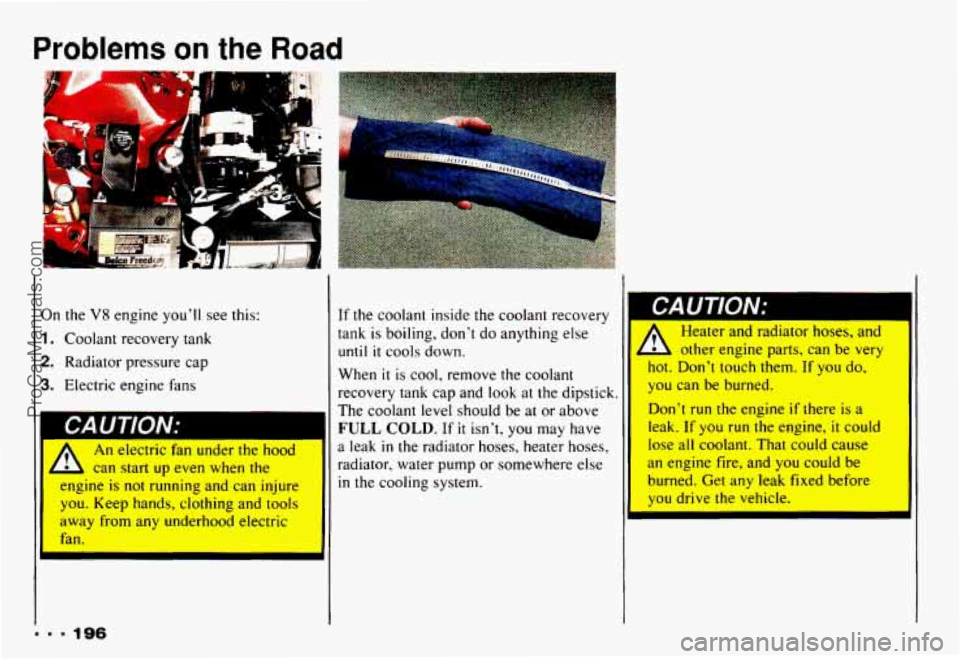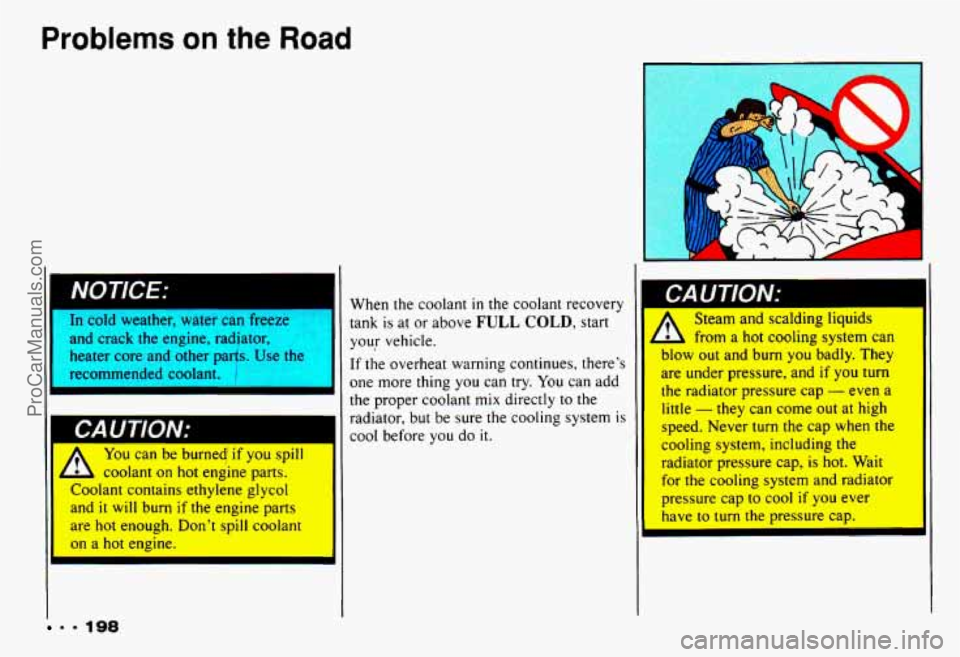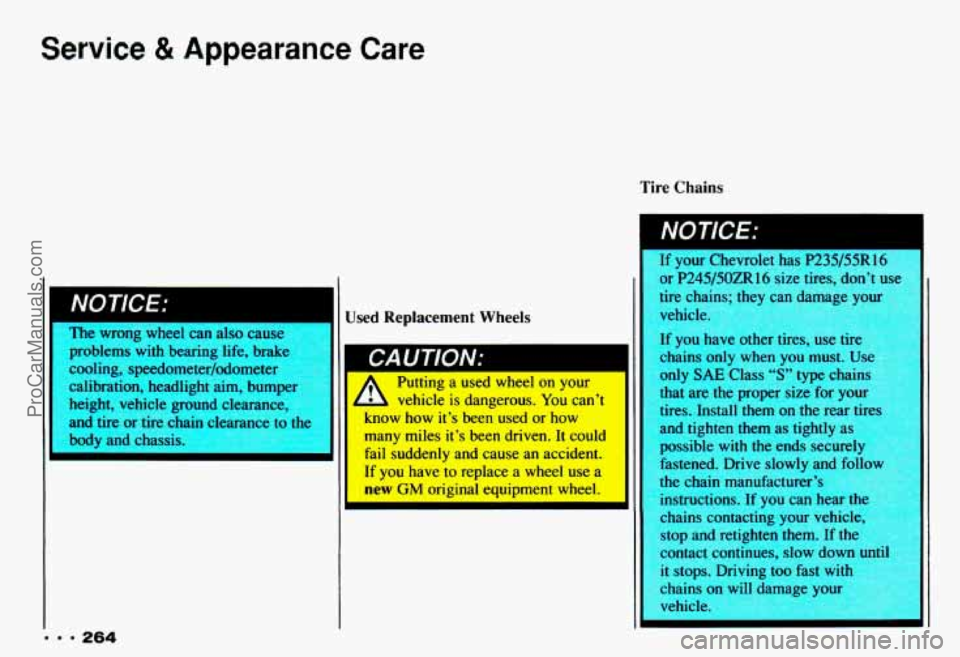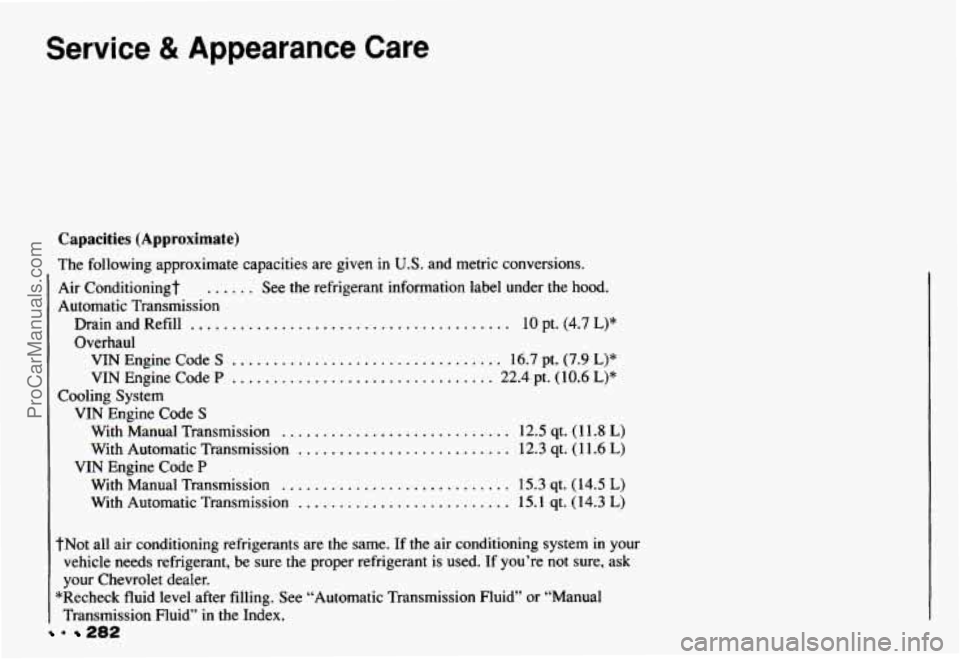Page 200 of 358

Problems on the Road
I. -
.. .
On the V8 engine you’ll see this:
1. Coolant recovery tank
2. Radiator pressure cap
3. Electric engine fans
An electric fan under the hood
L can start up even when the
engine
is not running and can injure
you. Keep hands, clbthing and tools
away from any underhood electric
fan.
... 196
I I
If the coolant inside the coolant recovery
tank
is boiling, don’t do anything else
until it cools down.
When
it is cool, remove the coolant
recovery tank cap and
look at the dipstick. I I
The coolant level should be at or above
FULL COLD. If it isn’t, you may have
a leak
in the radiator hoses, heater hoses,
radiator, water pump or somewhere else
in the cooling system. II
A Heater and radiator hoses, and
L other engine parts, can be very
hot. Don’t touch them.
If you do,
you can be burned. ~
Don’t run the engine if there is a
leak. If
you run the engine, it could
lose
all coolant. That could cause
an engine fire, and you could be
burned. Get any leak fixed before
you drive the vehicle.
ProCarManuals.com
Page 201 of 358

eng~ witho
r
u -.. .
tolar .-
[f there seems to be no leak, check to see
f the electric engine fan is running. If the
:ngine is overheating, the fan should be
-unning.
If it isn’t, your vehicle needs
iervice.
I I
How to Add Coolant to the Coolant
Recovery Tank
If you haven’t found a problem yet, but
the coolant level isn’t
at or above FULL
COLD,
add a 50/50 mixture of clean
water
(preferably distilled) and a proper
antifreeze at the coolant recovery tank.
(See “Engine Coolant”
in the Index for
more information about the proper
coolant
mix.)
A Adding only plain water to
L your cooling system can be
dangerous. Plain water, or some
I
other liquid like alcohol, can boil
before the proper coolant
mix will.
Your vehicle’s coolant warning
system
is set for the proper coolant
mix. With plain water or the wrong
mix, your engine could get too hot
but you wouldn’t get the overheat
warning. Your engine could catch
fire and you or others could
be
burned. Use a 50/50 mix of clean
water
and a proper antifreeze.
197-
ProCarManuals.com
Page 202 of 358

Problems on the Road
and crack the engine, radiator,
heater core and other parts.
Use the
recommended coolant.
‘I
A You can be burne4 if you spill
- L coolant on hot engine parts.
Coolant contains ethylene glycol
and
it will burn if the engine parts
are hot enough. Don’t spill coolant
on
a hot engine.
9.198
When the coolant in the coolant recovery
tank is at or above
FULL COLD, start
your vehicle.
If the overheat warning continues, there’s
one more thing you can
try. You can add
the proper coolant
mix directly to the
radiator, but be sure the cooling system is
cool before you do
it.
I
CAUTION:
Steam and scalding liquids
from a hot cooling system can
blow out and burn you badly. They
are under pressure, and
if you turn
the radiator pressure cap
- even a
little
- they can come out at high
speed. Never
turn the cap when the
cooling system, including the
radiator pressure cap,
is hot. Wait
for the cooling system and radiator
pressure cap to cool
if you ever
have to turn the pressure cap.
ProCarManuals.com
Page 203 of 358
How to Add Coolant to the Radiator
(3.4L L32 (Code S) Engine)
1. You can remove the radiator pressure
cap when the cooling system,
including the radiator pressure cap and
upper radiator hose, is
no longer hot.
Turn the pressure cap slowly
to the
left
until it first stops. (Don't press
down while turning the pressure cap.)
If you hear a hiss, wait for that to stop.
A hiss means there is still some
pressure left.
2. Then keep turning the pressure cap,
but now push down
as you turn it.
Remove the pressure cap.
P
3. Fill the radiator with the proper mix,
up to the base
of the filler neck.
ProCarManuals.com
Page 205 of 358
m
7. Then replace the pressure cap. Be sure
the arrows on the pressure cap line up
like this. Hom7 to Add Coolant to the Radiator
(5.7L LTl (Code P) Engine)
.
II
'he 1 engine (Code P) ha
;pecmc radiator fill procedure.
%lure to follow this procedure
1. You can remove the radiator pressure
cap when the
cooling system,
including the radiator pressure cap and
upper radiator hose,
is no longer hot.
Turn the pressure cap
slowly to the
left
until it first stops. (Don't press
down while turning the pressure cap.)
If you hear a hiss, wait for that to stop.
A hiss means there is still some
pressure left.
201 -
ProCarManuals.com
Page 242 of 358
Service & Appearance Care
What to Use:
Standard and Limited-Slip Differential
Use Axle Lubricant (GM Part No.
1052271) or SAE 8OW-90 GL-5 gear
lubricant.
Engine Coolant
The following explains your cooling
system and how
to add coolant when it
is low. If
you have a problem with
engine overheating or if you need to add
coolant to your radiator, see “Engine
Overheating”
in the Index.
I
The proper coolant for your Chevrolet
will:
0
0
0
0
0
Give freezing protection down to
-34°F (-37°C).
Give boiling protection up to 262°F
(128°C).
Protect against rust and corrosion.
Help keep the proper engine
temperature.
Let
the warning lights work as they
should.
ProCarManuals.com
Page 268 of 358

Service & Appearance Care
Tire Chains
IL
The wrong wheel can also cause
problems with bearing life, brake
cooling, speedometer/odometer
y!g@
calibration, headlight aim, bumper32
‘ i.i _. /8*
. .I )
height, vehicle ground clearance,
and tire or tire chain clearance to the
body and chassis. 1
... 264
Used Replacement Wheels
ruwllg it uscu WIIGGI UII yuul
vehicle is dangerous. You can’t
nnOW how it’s been used or how
many miles it’s been driven. It could
fail suddenly and cause an accident.
If you have to replace a wheel use a
new GM original equipment wheel.
Ib
If your Chevrolet has P235/55R16
or
P245/50ZRlf; cize tire. don’t 11c~ I
tire chains: the --In dm e vow I
I
vehicle.
If
you ,.-ve other tires, “st; LIIC
chains only when you must. Use
only
SAE Class “S” type chains
that are the proper size for
y
tires. Install them on the rear tires
and tighten them as tightly as
possible
with the ends securel)
fastened. Drive slowly and
folio
stop and retighten them. If the I
the chain manufacturer’s
instructions.
If you can hear th
chains contacting your vehicle
contact continues, slow down until
I
it stops. Driving too fast wit
chains on will damage yourg
vchicle.
I
ProCarManuals.com
Page 286 of 358

Service & Appearance Care
Capacities (Approximate)
The following approximate capacities are given in U.S. and metric conversions.
Air Conditioningt
...... See the refrigerant information label under the hood.
Automatic Transmission
Drain and Refill
....................................... 10 pt. (4.7 L)*
Overhaul VIN Engine Code
S ................................. 16.7 pt. (7.9 L)*
VIN Engine Code P ................................ 22.4 pt. (10.6 L)*
Cooling System
VIN Engine Code
S
With Manual Transmission ............................ 12.5 qt. (11.8 L)
With Automatic Transmission .......................... 12.3 qt. ( 11.6 L)
With Manual Transmission ............................ 15.3 qt. ( 14.5 L)
With Automatic Transmission .......................... 15.1 qt. (14.3 L)
VIN Engine Code P
tNot all air conditioning refrigerants are the same. If the air conditioning system in your
vehicle needs refrigerant, be sure the proper refrigerant is us\
ed. If you’re not sure, ask
your Chevrolet dealer.
Transmission Fluid” in the Index.
*Recheck fluid level
after filling. See “Automatic Transmission Fluid” or “Manual
. 282
ProCarManuals.com